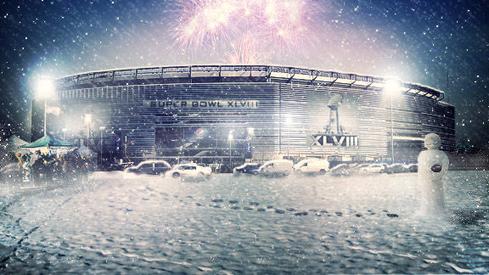Super Bowl Tech: A Supersized Role For Security
The cold weather has been the strongest story line throughout the entire NFL season. Sunday’s game will be no exception -- behind the scenes and on the field.

This week will be one of the most exciting weeks in recent sports history, kicking off Sunday with the first cold weather Super Bowl in the modern era and ending with the 2014 Winter Olympics opening ceremonies. Most of us will be watching the Super Bowl, but what does that fact have to do with IT security?
First, technology plays a role in everything today. In 2012, InformationWeek put together a nice slideshow called 9 Security Technologies for the Super Bowl and Beyond. It captures some of the tech that is used to secure some of the largest sporting events around the world. It's worth checking out as we focus this weekend on the Super Bowl.
Second, Super Bowl XLVIII has plenty of its own storylines: The league’s best offense versus the league’s best defense, old guard QB versus upstart QB. But the cold weather aspect has been the strongest story line throughout the entire NFL Season. Just look at the weather forecast: 27-44 degrees by game time with a slight wind projected for Sunday night.
The cold weather inserts more security and public safety issues that must be monitored and managed. For example, people will be wearing more layers of clothes, and there are significant travel restrictions heading to MetLife Stadium. Furthermore, we all know that cold weather and hardware don’t always mix. That not mixing creates an additional strain on the technology that helps law enforcement do its job.
It’s a Super Bowl-sized example of physical security and IT convergence. Covering more than 2 million square feet over nearly 13.5 acres, with seating for 82,500 fans, 222 suites, and four club lounges with more than 9,000 club seats, MetLife Stadium and the surrounding facilities and activities around Super Bowl weekend represent a massive area to monitor and secure to ensure public safety.
I’ve seen these types of events from behind-the-scenes and there are many ways that IT will play a vital security role:
IP Video: IP-based surveillance cameras provide security and operations personnel with HDTV- and megapixel-quality video, a significant upgrade from the grainy CCTV feeds of the past. Like any other network-connected device, these cameras need to adhere to the same IT security protocols to ensure the devices, and the live and stored video footage on the network, are all secure.
Collaboration: The NFL, MetLife Stadium, New Jersey Transit, and the New Jersey State Police have been collaborating for months. Beyond requiring procedures and traffic patterns for fans, staff, and public safety personnel, a globally-watched event in a public venue has its own security challenges. IP technology allows security organizers to bring public and private video feeds into a centralized control room. This enables greater collaboration; more contextual analysis; and a quicker, orchestrated, and more appropriate response to any situation.
HDTV: Security managers can now quarterback the control room. They finally have an HD view of the game with the same quality we see at home. They can catch more "plays" they might otherwise miss, both inside the stadium and elsewhere on the premises. Crisp pictures and powerful pan/tilt/zoom (PTZ) capabilities, combined with video monitoring software (VMS), allow them to identify incidents quickly, track the sequence of an incident, and respond effectively. In the past, by the time guards responded to an incident, the perpetrators had often moved on. Today, technology helps stitch together the sequence of events to help locate a lost child, break up a drunken fan-fight or an out-of-control tailgate party, or respond to a public safety concern. The control room acts as a calm QB, directing the team to be in the right place for each play.
Wireless Remote Access: Wireless access literally puts HDTV-quality video in the palms of the hands of patrol members who can see exactly what’s happening in real-time instead of relying on a radio feed from the control room.
Temporary Networks: IP technologies allow for quick set-up and break-down of temporary networks. IP video, wireless technologies, and power-supply capabilities make it easier to support the additional security required for the game and all the surrounding festivities. It’s simply another network drop vs. having to trench cable -- a more permanent requirement of the past. This allows for activities to sprawl out over a greater distance while remaining under control.
It’s not just about security either. Remember, last year when a power outage at the Superdome knocked Super Bowl XLVII out of commission for more than a half hour? That was a transformer problem that became more of a story than the game itself, and highlighted how disruptive a blip in IT and facilities operations can be. When the lights go out, it not only leaves fans in the dark, but the operations personnel as well.
The complex security environment surrounding major sporting events offers great perspective for enterprise security teams on how to prepare, monitor, and respond to security threats -- both physical and cyber. Take a lesson from the Super Bowl. Let’s chat about the game -- from a security or a sports focus -- in the comments.
About the Author(s)
You May Also Like
Beyond Spam Filters and Firewalls: Preventing Business Email Compromises in the Modern Enterprise
April 30, 2024Key Findings from the State of AppSec Report 2024
May 7, 2024Is AI Identifying Threats to Your Network?
May 14, 2024Where and Why Threat Intelligence Makes Sense for Your Enterprise Security Strategy
May 15, 2024Safeguarding Political Campaigns: Defending Against Mass Phishing Attacks
May 16, 2024
Black Hat USA - August 3-8 - Learn More
August 3, 2024Cybersecurity's Hottest New Technologies: What You Need To Know
March 21, 2024




